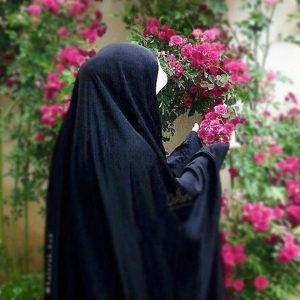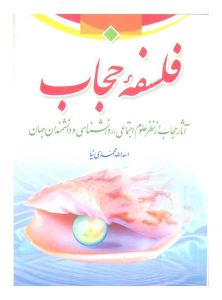FALSAFEH EJTEM Ā‘Ī HIJ ĀB: DARĀMADĪ BAR JĀME‘EH SHENĀSĪ LEBĀS WA PŪSHESH [THE SOCIAL PHILOSOPHY OF HIJĀB: AN INTRODUCTION TO THE SOCIOLOGY OF DRESS AND COVERING]. By Ali Qanbari Barziyan , Ibrahim Rezaei. Tehran, Iran: Hekmat wa Erfan Publication. 2019. Pp. 269. Paper. 500,000 IRR.
Throughout history, there has been a profound connection between clothing and culture in human societies, such that cultural changes have resulted in shifts in dress. The Iranian society has undergone gradual cultural transformations since the Qajar era, and the pace of these changes significantly increased during the Pahlavi period. Various works have been produced in this field; however, what distinguishes this particular work is the author’s historical and analytical perspective on the issue of hijab in human societies.
This work is composed of five chapters accompanied by an introduction. In the first chapter, general inquiries regarding hijab are presented, addressing questions such as whether hijab is a cultural, religious phenomenon or a political-security one. Is the acceptance of hijab among women in a religious society based on tradition, contract, or compulsion? Is hijab a right, an obligation, or both? How does hijab relate to the demands of time and the modernization process? The author further elucidates the history of hijab within Iranian culture, arguing that respect for modesty has manifested not only in dress and social interactions but also in architecture and various dimensions of social, economic, and cultural life. Thus, representations of women are notably scarce in ancient Iranian paintings and carvings. Additionally, within the Aryan faith, covering the face was attributed to the higher status of women in society. Historians, Orientalists, and travel writers have consistently noted that throughout history, Iranians have been recognized for their complete body coverings, from head to toe. “Count Gobineau, in his work ‘Three Years in Iran,’ asserts that the stringent hijab of the Sassanid era persisted among Iranians during the Islamic period.” It is worth noting that hijab is not exclusive to Iran or the Islamic religion; it has also existed among past nations, ethnic groups, and other religions.
 The second chapter delves into the sociology of dress and covering. It begins by posing the question: Is covering and hijab a cultural discourse in the modern world? The author notes that historically, clothing and covering indicated an individual’s social status and held meaning; however, in modernity, this significance has declined. Today, rather than serving as a marker of social position, clothing displays individual personality. Within the framework of relativism, the author views hijab as a matter grounded in customs, traditions, religion, and socio-national interests that is socially accepted and agreed upon. The right to hijab is seen as the actualization of these rights and broader freedoms. Sociologists argue that wearing good clothing is indicative of a person’s social value; clothing is so pivotal in sociology and anthropology that the concept of a “language of clothing” has emerged. The author then discusses the social and cultural functions of clothing. One of these functions is demonestration, meaning that individuals wear clothing to showcase their social power to others. Another function is decorative, whereby clothing transcends basic needs and is purchased to achieve a higher status. A further aspect is the pleasure-seeking function, indicating that purchasing clothing occurs for enjoyment and entertainment.
The second chapter delves into the sociology of dress and covering. It begins by posing the question: Is covering and hijab a cultural discourse in the modern world? The author notes that historically, clothing and covering indicated an individual’s social status and held meaning; however, in modernity, this significance has declined. Today, rather than serving as a marker of social position, clothing displays individual personality. Within the framework of relativism, the author views hijab as a matter grounded in customs, traditions, religion, and socio-national interests that is socially accepted and agreed upon. The right to hijab is seen as the actualization of these rights and broader freedoms. Sociologists argue that wearing good clothing is indicative of a person’s social value; clothing is so pivotal in sociology and anthropology that the concept of a “language of clothing” has emerged. The author then discusses the social and cultural functions of clothing. One of these functions is demonestration, meaning that individuals wear clothing to showcase their social power to others. Another function is decorative, whereby clothing transcends basic needs and is purchased to achieve a higher status. A further aspect is the pleasure-seeking function, indicating that purchasing clothing occurs for enjoyment and entertainment.
The third chapter addresses the issue of hijab in Iran. Given the transformations in lifestyle in today’s world, particularly in Iran, the culture of modesty has been severely compromised in recent decades. According to the author, the influences of modernity and Western material culture have played significant roles in this process, overshadowing various aspects of Iranian lifestyles. The author examines different forms and types of hijab usage. In the first type, hijab is regarded as a religious obligation adhered to due to divine commandments. The second type is identified as an ideology; the political ideologies of these individuals have created a specific lifestyle for them. This group believes that their covering has symbolic and identity functions, especially regarding religious and ideological identity, shaping their mode of dress. They hold that the type of covering and hijab reflects individuals’ identities, both in belief and practice. The other type is characterized as reactive and introspective, where women exhibit particular resistance against certain clothing models and strive to establish their clothing consumption patterns based on personal preference, need, or ideologies outside of fashion. According to Brian’s philosophical analysis of social action, hijab is presented as a social act based on four key conceptual layers: beliefs, values, norms, and symbols. Here, beliefs legitimize values; values justify norms; and symbols represent and manifest norms that are actualized in social behavior and action. Consequently, the belief that women’s hijab is a clear directive of the Quran serves to justify the value and dignity of women and the importance of maintaining modesty and chastity, thus legitimizing the norm that women must observe hijab in interpersonal relations. The author posits that hijab is a cultural and social symbol for Iranians, with its origins predating the advent of Islam, reaching a peak of elevation within the Islamic culture while countering immodesty as a deviation from social norms (normative disruption) based on time, place, and the causes behind it. Moreover, hijab is described as a medium of symbolic communication, reflecting the nature of interpersonal relations with women, which depends on the type and extent of women’s covering. According to a functionalist approach, various aspects of society are conceptualized based on their beneficial outcomes for the larger social system. Among these functions are social psychological well-being and the reduction of sexual tensions, strengthening familial bonds and ensuring intimacy between couples, social stability and workforce productivity, and ultimately creating a secure environment for women that can serve as a preventative measure against immorality and inappropriate mingling between men and women in society.
 The fourth chapter reviews some of the most significant research conducted in recent years, particularly focusing on students and youth. According to data collected from Tehran citizens, respondents prioritized family consolidation, respect for women’s status, societal health, social immunity, and limiting women’s activities as reasons for the necessity of hijab. In response to the type of hijab deemed acceptable by respondents, options included chador, manteau and hijab, manteau with headscarf, any type of clothing with head covering, or none at all. Another study conducted with female students at Bahonar University in Kerman highlighted the reasons for their inadequate hijab, examining students’ religious status, political attitudes, and family backgrounds. A further analysis among students at Payame Noor University in Shahrekord identified factors influencing the spread of hijab culture, which include emphasizing the positive aspects of hijab, articulating its philosophy and benefits for youth, fostering appropriate models, utilizing friendly and respectful methods in addressing immodesty, teaching proper conduct for men and women in society, educating on hijab’s principles, considering the adverse effects of mass media, familial and university environment pressures, peer group influences, and formulating public laws and decrees regarding hijab. The author concludes that the primary responsibility for addressing hijab lies with the government, albeit this does not imply a complete denial of civil society’s role; instead, cultural development should be state-centered. Nevertheless, hijab is fundamentally a cultural-legal phenomenon, the parameters of which are outlined in jurisprudence, but a significant portion is rooted in culture, raising questions about whether chador or manteau constitutes hijab. Sociologists encourage society to achieve normative consensus and advocate that the hijab issue requires normative agreement among the population rather than a coercive approach, in order to prevent conflicts arising from hijab.
The fourth chapter reviews some of the most significant research conducted in recent years, particularly focusing on students and youth. According to data collected from Tehran citizens, respondents prioritized family consolidation, respect for women’s status, societal health, social immunity, and limiting women’s activities as reasons for the necessity of hijab. In response to the type of hijab deemed acceptable by respondents, options included chador, manteau and hijab, manteau with headscarf, any type of clothing with head covering, or none at all. Another study conducted with female students at Bahonar University in Kerman highlighted the reasons for their inadequate hijab, examining students’ religious status, political attitudes, and family backgrounds. A further analysis among students at Payame Noor University in Shahrekord identified factors influencing the spread of hijab culture, which include emphasizing the positive aspects of hijab, articulating its philosophy and benefits for youth, fostering appropriate models, utilizing friendly and respectful methods in addressing immodesty, teaching proper conduct for men and women in society, educating on hijab’s principles, considering the adverse effects of mass media, familial and university environment pressures, peer group influences, and formulating public laws and decrees regarding hijab. The author concludes that the primary responsibility for addressing hijab lies with the government, albeit this does not imply a complete denial of civil society’s role; instead, cultural development should be state-centered. Nevertheless, hijab is fundamentally a cultural-legal phenomenon, the parameters of which are outlined in jurisprudence, but a significant portion is rooted in culture, raising questions about whether chador or manteau constitutes hijab. Sociologists encourage society to achieve normative consensus and advocate that the hijab issue requires normative agreement among the population rather than a coercive approach, in order to prevent conflicts arising from hijab.
In the concluding chapter, the author presents their final thoughts on the topic of hijab, asserting that the issue is not merely about changing forms and appearances, but rather about mindset. Hijab represents a value alongside other values; however, due to its outward manifestation, it tends to attract attention more quickly. State intervention in cultural matters may lead to disruptions. Ultimately, the discourse on clothing must be settled within the realm of epistemology, planned in institutions beyond the state to ensure it is not forgotten with changing administrations over time.
This work provides valuable information on the issue of hijab in Iran for the reader, encompassing various dimensions of the subject. However, one aspect that the author could have explored in greater depth is the historical evolution and changes of the hijab in Iran from the past to the present. This exploration could have offered more precise and substantial insights for the analysis of this topic for the audience.
Hossein Baqeri
Tolou International Institute
